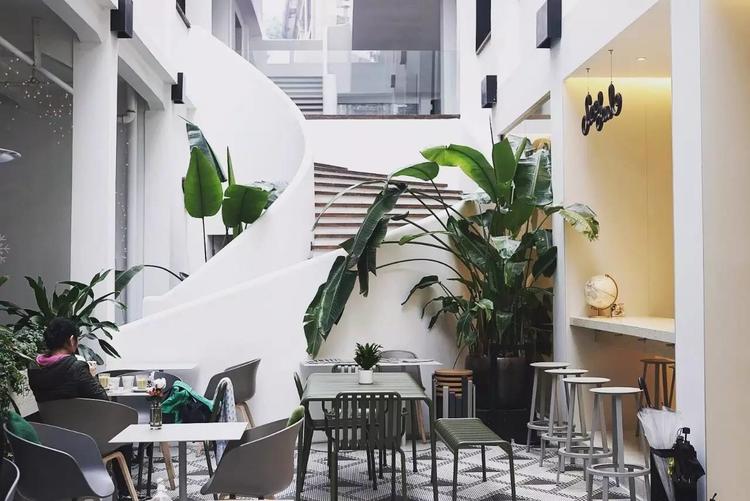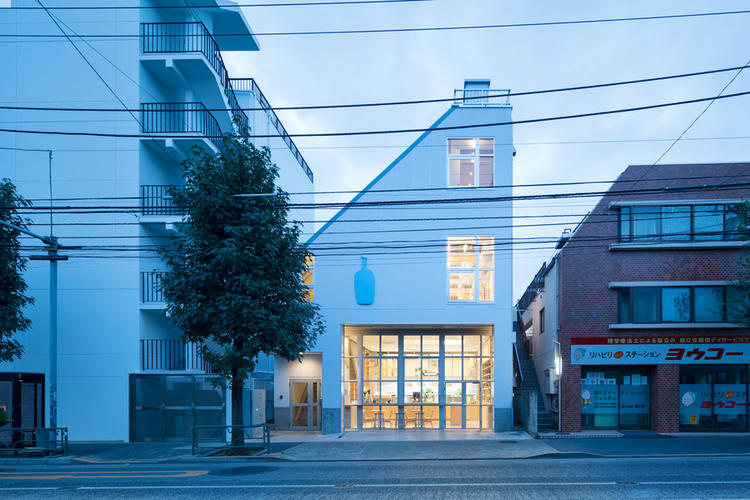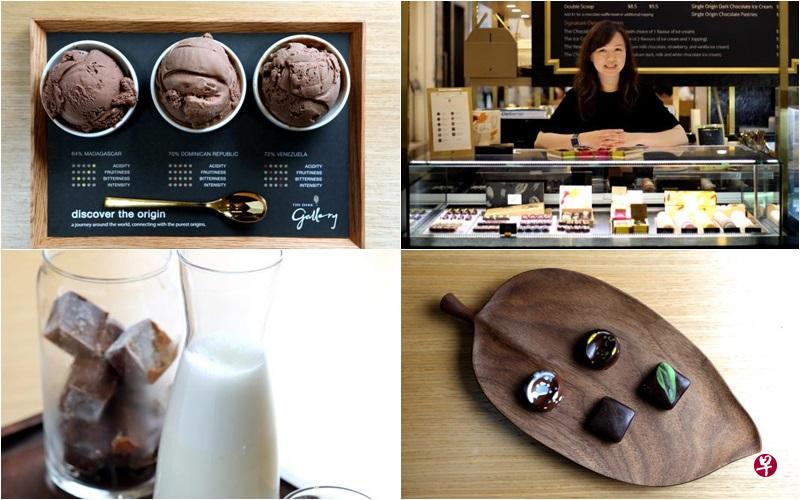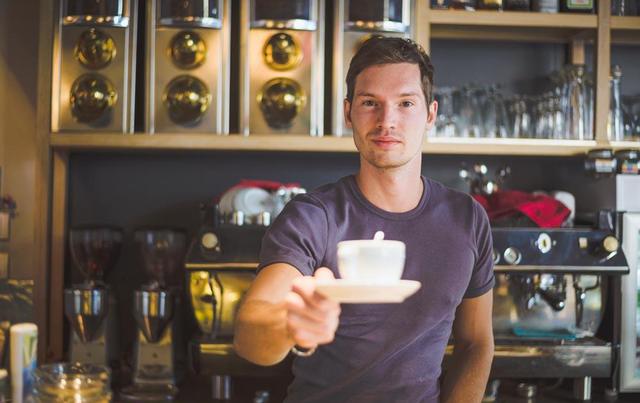Boutique coffee Seesaw, how far is it from the goal of 100 stores?
For professional baristas, please follow the coffee workshop (Wechat official account cafe_style)
How should boutique coffee chains be compatible with these two paradoxical elements if they not only have a sense of freshness, but also pursue expansion efficiency?
After opening its first store in Shanghai Jing'an Design Center in 2012, boutique coffee Seesaw opened seven stores in five years.
In June this year, Seesaw reported that it had received 45 million yuan of A-round investment from Baifu Holdings, which is owned by Hony Capital, and plans to open 20 stores by the end of the year.
That means it will open more stores this year than in the past five years.
The coffee industry is known as "six losses, three equals and one profit". "usually when you open a coffee shop, you have to do several accounts. Rent, logistics costs and labor costs, as well as passenger flow, turnover rate and passenger unit price, "said Wang Juntao, founder of Shanghai boutique coffee brand Yingji Coffee. He has worked for a South Korean coffee brand consulting company and has experience in coffee trading. Before founding Eagle set, he was the CEO of another domestic chain of boutique coffee. "A lot of people rely on their feelings to open a cafe, but they haven't calculated the account very carefully."

Today, there are two phenomena in the boutique coffee industry: independent stores are constantly emerging, and a number of brands are seeking to operate on a large scale.
Zheng Songmao, founder of quality Coffee, has claimed to open 10,000 boutique cafes in China, with a goal of landing 1000 franchise stores in 2016. It recruits franchisees and reduces the cost of opening stores on O2O platforms like Ma Xiansheng, although there are still only 10 stores in Shanghai.
Mellon Coffee, which started from the coffee industry chain, began to expand in 2016. at present, there are more than 20 direct chains in the country and two stores in Singapore.
Eagle set, which only opened at the beginning of this year, is preparing a 30 million yuan round of Pre-A financing and plans to open another one on Nanjing West Road in Shanghai by the end of this year, in addition to an existing fixed store and a 100-day flash store.
Even around the world, there are only a handful of boutique cafes on a large scale. The brands that coffee operators are interested in talking about are Blue Bottle, Stumptown and Intelligentsia, but at present, only Blue Bottle has realized a large-scale chain operation, with 38 stores worldwide since its establishment in 2002.

"some brands have only been established for two years and have already set up ten branches and even opened in Singapore, a scale that Taiwan coffee people can't imagine." Gabee. Lim Dong-Won, founder of coffee, sighed. In Taiwan, where coffee accumulation is deeper, many experienced baristas have been invited to the mainland to work as coffee brand consultants. Lim Dong-Won is one of them. He has been performing in Shanghai since 2005. In addition to being a consultant for the Stay Real brand, he is also a beverage consultant for more than a dozen cafes in Shanghai.
Compared with Starbucks, which is based on a fully automatic espresso machine, boutique coffee has a lot of manual factors-such as emphasizing craftsmanship, focusing on the differentiation and particularity of coffee beans, and stores have different design styles.
Seesaw is one of the earliest practitioners. Founder Zong Xinkang and Wu Xiaomei are a couple with no background in the coffee industry, but have established a stable reputation in five years. Most of its revenue comes from coffee, desserts are provided by suppliers and do not sell meals. In the view of investor Baifu Holdings, this simple model also reduces the difficulty of replication.
In the past five years, Seesaw has closed a total of five stores that failed to locate and locate, and has gradually increased its cooperation with commercial real estate, and now has 11 stores. In an interview with the media, the phrase "Starbucks of China" also appeared in Zong Xin Kuang's description.
Like upgraded snack bars, coffee shops with coffee beans and independent temperament as selling points, only chains can attract investment attention.
Zong Xinkang and Wu Xiaomei, who had just visited coffee-producing areas in Yunnan and raised a sum of money from relatives and friends, had originally written their business plan to open 15 stores.
When Seesaw opened his first store on Yuyuan Road in Shanghai, he rented several inconspicuous houses in the backyard as warehouses and "coffee training colleges". The place with beans, espresso machines and all kinds of sundries is in line with Zong Xinkuang's setting of the company model: it has an "ecological" model for comprehensive profits, participates in the cultivation of Yunnan coffee beans upstream, and has stores downstream. It can also cultivate consumers' coffee culture.

Seesaw Coffee opened its first shop on Yuyuan Road.
But this complete "ecology" is more like a term honed in the process of seeking investment, and by 2017, Zong Xinkuang's description of the Curiosity Daily also "hopes to connect all coffee lovers through technical means, provide products for boutique coffee shops, carry out commercial cash, and share Seesaw's business skills and information."
Zong Xinkuang was born in IT, and this statement is also in line with the current "sharing", "platform" tuyere hot spot. However, Zong Xinkuang also admitted that he "does not know what form Seesaw will exist in."
The expansion of boutique coffee is a topic everywhere. Just as the media industry always mentions when it comes to ecology, Monocle,Blue bottle is also a model for the boutique coffee world-it appears repeatedly in the mouth of several coffee shop operators we interviewed.
The value of this brand is that it has grown from Oakland to 38 stores around the world, maintaining high quality and excellent reputation. It demonstrates the potential capabilities of boutique coffee in a form of large-scale retail: selling iced coffee like milk, developing and promoting new coffee-making methods to stores, selling hand-brewed coffee travel packages, attracting consumers with digital content, and, selling peripheral products with design beauty.

But the biggest difference between domestic boutique coffee and Blue Bottle is that it attaches great importance to the flow of people and location.
James Freeman, founder of Blue Bottle, told the Washington Post that they did not rely on demographics and market research to choose the location of the store. He thinks he and CEO Bryan Meehan are more intuitive than analysts.
Of Blue Bottle's six stores in Japan, with the exception of Nakamoto and Shinjuku, which are located in the comparative center of Tokyo, the other four belong to the secluded type at first glance.
But this is actually a cunning strategy: these locations (such as the clear White River in Tokyo) fit well with Blue Bottle's target audience-the creative class that pursues independence and aesthetics, and the followers radiated by them. At the same time, such areas can avoid high rents in areas with high flow of people and save costs.

Blue Bottle has a black shop in its fifth store in Tokyo, near where artists live.
The existence of such "independent and secret" has become the pursuit of many people, but blind replication will lead to destruction. Blue Bottle's location strategy is based on a mature coffee culture-the competition for independent cafes in Tokyo and San Francisco is fierce-and its confidence comes from being able to set itself as a consumer's destination, not just impulsive buying.
Seesaw thinks he faces a completely different crowd. Wu Xiaomei told Curiosity Daily: "for Seesaw, [consumers] are young people in China, a little younger, different from them (Blue Bottle)."
From the third store, Seesaw began to shift its location to crowded shopping malls and office buildings, breaking the tradition of opening small shops for boutique coffee. They run from west to east along the horizontal axis of Shanghai, from Ruiou Department Store in Jing'an Temple to Huaihai Road and all the way to the Jiali City Plaza Store in Pudong.

Seesaw's iAPM store
Eagle set's store opening strategy is also very similar. "the Eagle set store opening path should run through the Huangpu River, Huaihai Road and Jing'an Temple." On the central axis of Shanghai, "says Wang Juntao. The rental cost of Eagle set in Xintiandi store is as high as 600000 yuan a month, and the next store under preparation will be on Nanjing West Road, which is also a first-class business district with a dense flow of people.
This location strategy takes into account that the store has the function of advertising space, and brand promotion is still the focus. A large part of Seesaw's location reference refers to Starbucks' precise calculations, or in other words, Seesaw may also consider where Starbucks may appear.
But it also means that they will face the competition from Starbucks and will fall behind to a large extent.
"to be honest, we can't get the same seats as Starbucks now, especially in Shanghai. If we go to other cities, we may still win as a new brand. " Zong Xinkang said.
Their third store is on the fifth floor of Shanghai Ruiou Department Store. This is one of the most competitive locations in Shanghai cafes: there are three Starbucks on the ground floor and in the building, two coffee shops embedded in the bookstore downstairs, and Cafe de Paris, another chain coffee brand, next to Seesaw.

The location of Seesaw on the fifth floor of Reo Department Store used to be a small shop, but now it has become a 200m2 open space.
Choosing a location according to Starbucks' rules of the game is largely a competition between network resources and capital.
Shopping malls that are in demand for differentiation are an opportunity to pay more attention to the value of boutique chains of coffee. Seesaw is even better positioned on the first floor of Shanghai's Xintiandi Ryan Square than Starbucks: it has little competition and monopolizes the coffee business in the building.
The expansion of boutique coffee is often seen as a response to the demand for "consumption escalation".
Although boutique coffee is widely recognized as a clear definition: the national coffee organization gives coffee beans a score of more than 80 points. But coffee shop chains say they sell not only that cup of coffee, but a lifestyle, and rely on content output to attract customers.
The most direct manifestation of "content output" is that in addition to providing coffee beans with 80 or more points, the cafe may also provide special coffee containers, popularize new tasting and drinking methods to consumers, and emphasize barista culture, in-store design and its own brand value.

In the past year, you will find that both Seesaw and Yingji Coffee have done a lot of cross-brand cooperation activities. Eagle set opened a 100-day pop-up store next to Audrey Hepburn's booth, while Seesaw invited designers to hold design sharing sessions and work with sports brand Adidas Originals and buyer store pillars.
However, both Seesaw and Eagle set say that the quality of domestic boutique coffee is as good as that of foreign countries, but talent is the main factor in opening up the gap between domestic and foreign cafes.
"they (foreign baristas) have a good personality, self-expression, and they have the ability to do business, and we also hope to let more people know about these things." This is the difference between Chinese and American baristas summed up by Wu Xiaomei.

From Weibo: @ seesaw
Baristas in mainland China do not have a continuous blood transfusion channel, and it turns out that the bartender who worked at the bar was the main force of baristas in the early days. It is not difficult to master the skills of making a cup of coffee, but one of the differences between the third wave of coffee and the first two waves is to promote the culture of coffee producing areas, which requires baristas to have a complex coffee knowledge system and the ability to explain deeply and simply. On the other hand, the standard for recruiting baristas in many cafes is more like recruiting a waiter, with limited academic qualifications and qualities.
"when ta extends to the management or technical level, it will be more difficult. This is the part of our distance from foreign boutique coffee brands. " Wang Juntao said.
Uncompetitive wages also make baristas highly mobile. Baristas generally have a monthly salary of about 3000 to 6000 yuan, which is difficult to retain good employees. In this income bracket, baristas are just one of dozens of options for service industries such as real estate agents and restaurant waiters. Without a complete promotion mechanism, baristas are likely to be a temporary springboard for many people during the confused period of life.
For this reason, quality Coffee chooses a fully automatic coffee machine of the same size as Starbucks, so as to eliminate the influence of the greatest uncertainty of "people".
Both Seesaw and Eagle offer slightly higher salaries than the industry, while setting up a relatively complete promotion path for baristas.
Wang Juntao is happy to emphasize the seven grades that Eagle sets for baristas: from junior high school to supervisor, store manager and regional manager, each level corresponds to a post salary. When baristas reach the senior level, they will extend two promotion paths: one is specialization, they can participate in competitions and flow to the direction of training, and the other direction is management, participating in store opening, operation or consulting.
Wu Xiaomei believes that Seesaw's efficient training mechanism is attractive-so they choose the background of baristas more consciously than their experience.
"baristas come from a variety of backgrounds and have designs. Some of them used to be English teachers, but they all had different backgrounds, but they were interested in coffee a long time ago. This is what we have a relative advantage at present. " Zong Xinkang says that the baristas they recruit are better than the average catering industry in terms of education and status.
At present, Seesaw has more than 100 employees, mainly from Starbucks manager level employees, boutique coffee shop practitioners and recent graduates. "most of them are art schools and students majoring in tourism management or hotel management."
Wu Xiaomei claims to be ready for an expansion of 100 to 300 people. With an investment of 45 million yuan, in addition to the funds used to expand the store, the rest of the Seesaw will be used to hire professional consulting firms to sort out the talents needed for the store development plan.

Seesaw Yuyuan Road Store
The second obstacle to scale is store design and engineering efficiency.
Seesaw's current stores do not take into account the need for scale, they are the product of Zong Xin Kuang looking for help.
Zong Xinkuang used to run an architectural design company and has the ability to judge style. Tom Yu, who used to be the head of Heatherwick Studio's Asian project, was his friend and helped design the first store. At present, each Seesaw store designer is not the same person, showing a completely different style.
This non-replication dispels the fatigue caused by chain operation, but the slow form of cooperation also makes the design a time-consuming and laborious uncertain factor.
The preparation period for a Seesaw store is about three or four months, and it can reach two months in case of emergency, which is faster than in the past. But to reach the speed of opening 10 stores a year, it is obviously not appropriate to follow the pace of the past.
Zong Xinkuang likes to mention the designs of "intellectuals" and "Shu Dun City". They all have strong artistic characteristics. "A very natural, very close feeling, not very deliberate." he thinks that Seesaw "exerts a little too much force, adding something that allows you to take selfies in order to cater to consumers' preferences."
Seesaw believes that the selling point lies in the bar, "so that customers can see the whole coffee making process and communicate with the clerk at any time." at the same time, "customers can sit and watch the barista's performance like a show."

Such a design has been standard since the first store, but rapid expansion must follow the pace of the mall, which has its own property management and is not always in line with Seesaw's arrangements. Several of the 20 stores that Seesaw will open this year have been delayed due to delays in the opening of the mall.
Seesaw is expanding the company because of team management, space design and product line expansion.
Generally speaking, few boutique cafes have an independent marketing department. But these cafes, which are planning a large-scale expansion, have public relations and publicity departments, including designers, copywriters and planners.
This is a huge test for the energy of the founders. Holding several meetings a day, finding dessert suppliers for Seesaw and decorating eight stores at the same time has become a daily routine for Zong Xinkuang. Capital, activities and brand influence are all things they think about every day.
"most of the time I think about our structure, our direction." Zong Xinkang said. He not only studies American coffee brands, but also looks for inspiration from other industries. Although he doesn't know the pronunciation of Supreme, the street brand that fascinates many young people is the cross-border partner he hopes to understand and cooperate with.

In order to increase turnover, Seesaw needs to increase the proportion of meals, but the right supplier is always a constraint.
There are also some obvious changes: Seesaw's first store attracted foreigners and coffee lovers familiar with coffee culture, but the combination with the mall turned the original coffee lover into a white-collar worker with a hard need for caffeine.
Moreover, Starbucks has formed an all-pervasive network, selling "standardization" and "convenience" while evoking brand identity with huge flagship stores. Moreover, since 2017, overseas brands have continuously entered the Chinese market: Peet's, a coffee brand more senior than Starbucks, will land in Shanghai, and even illy Coffee, which has always focused more on wholesale business, has opened an offline store in Hangzhou.
The addition of capital can help Seesaw get stronger talent and store addresses, which is what Zong Xinkuang and his wife have been doing since they opened. Individuals or investment institutions keep finding Seesaw in the middle, but they don't talk about it in the end.
At the end of 2016, Ma Yun put forward the concept of "new retail" at Yunqi Conference, and offline opportunities became the topic again. Hony Investment, which claims to invest Rmb10bn in the catering industry, has thrown its intention at Seesaw against this background. This investment institution is also the controlling party of PizzaExpress, Beijing Fast Food "Hehegu","West Young Master","Meina Restaurant" and other catering brands.
While Hony hasn't yet asked for a specific number for Seesaw, they hope Seesaw will be No. 1 in the specialty coffee category and open 100 stores nationwide--a number no one has ever reached in the industry.
Zong Xinkuang mentioned several times: "How to expand to a certain scale in this stage, but without losing some small and beautiful characteristics." I think this is the hardest part."
Photo from: Upslash
Important Notice :
前街咖啡 FrontStreet Coffee has moved to new addredd:
FrontStreet Coffee Address: 315,Donghua East Road,GuangZhou
Tel:020 38364473
- Prev

"Food theme" cafes are on the rise! Cheese tarts, dark chocolate, what's next?
The exchange of professional baristas Please follow the Coffee Workshop (Wechat official account cafe_style) following the debut of various cartoon character themes and IP-themed cafes, in recent years, there is also a new food-themed cafe, which is also quietly emerging. More distinctive cafes include The Dark Gallery, which specializes in dark chocolate drinks and desserts, and P with cheese as its theme.
- Next

The unmanned coffee shop is really coming! How should coffee shopkeepers deal with it?
Professional baristas Please follow the Coffee Workshop (Wechat official account cafe_style) in early July, Jack Ma launched a new concept of unmanned coffee shop Amoy Coffee on Taobao Festival, leading to a wave of new unmanned retail outlets. (portal: the latest operation of Jack Ma's poop) if Jack Ma's coffee shopping is just a gimmick with no one to check out, it has nothing to do with the coffee industry at all.
Related
- What documents do you need to go through to open a coffee shop? coffee shop coffee shop certificate processing process
- How to purchase Coffee beans in small Cafe how to choose a suitable supplier for domestic Coffee supply Company
- How to drink Starbucks Fragrance White Coffee? how to make Australian White Coffee? what Italian coffee beans are recommended?
- The Story of Flora Coffee: the name of Flora Coffee Bean and the implication of the Flowers on Florna Coffee
- How much does a cup of coffee cost? How much is the profit of a cup of coffee? What is the profit of the coffee shop in a year?
- Yunnan small Coffee, known as "fragrant Coffee", introduces the characteristics of Alpine Arabica Coffee producing areas in Yunnan, China
- 2023 latest Starbucks full menu price list how much is a cup of Starbucks coffee what is better to drink the most popular hot and cold drinks recommended
- Starbucks different kinds of Coffee Price list Starbucks menu 2023 Top Ten Best drinks in Starbucks
- Starbucks Spring praise Comprehensive matching Coffee Bean theme Story Packaging implication and taste description
- The cost of a cup of coffee latte American coffee cost price and selling price

